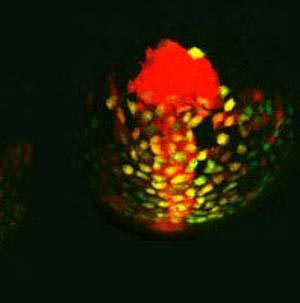July 7, 2016
Temporal signaling pattern regulates a cell’s destiny
IST Austria researchers reveal temporal signaling pattern regulating cell fate specification | Collaborative work of Heisenberg and Janovjak groups | New optogenetic tool developed to examine the role of temporal signaling during embryonic development of zebrafish | Study published in Cell Reports

During the early development of multicellular animals, cell fate decisions have to be taken to determine what the final cells of the developing organism will be. The biological process responsible for the development of the organism is steered by signals called morphogens, which govern the pattern of tissue development. There is increasing evidence that the temporal pattern of morphogen signaling plays an important role in this process. Yet, tools for temporally controlling morphogen signaling within the embryo are still scarce in order to prove the correctness of this assumption. Researchers from three different institutes – among them the Institute of Science and Technology Austria (IST Austria) – demonstrated that the duration of signaling affects cell fate specification within the developing embryo and presented their findings in Cell Reports, published on July 7, 2016 (DOI: http://dx.doi.org/10.1016/j.celrep.2016.06.036).
Controlling the signaling patterns
Recent advances in optogenetic methods make it possible to manipulate cell signaling so that certain signaling pathways can be turned on or off similar to a light switch. Researchers at IST Austria developed a photoactivatable receptor to determine if the temporal pattern of morphogen signaling affects cell fate specification during zebrafish gastrulation, a period in early embryonic development where the three germ layers – ectoderm, mesoderm, and endoderm – are established.
The researchers used this receptor to manipulate the duration of a specific morphogen signaling pathway in vivo by light, namely the Nodal signaling pathway. The experiments showed that extended Nodal signaling within the embryo influences the expression of genes involved in mesoderm and endoderm cell fate specification, and the duration of Nodal signaling decides whether a cell becomes mesoderm or endoderm. Thus, by taking advantage of optogenetic regulation of cell signaling within the developing embryo, the authors provide direct evidence supporting the assumption that the temporal pattern of morphogen signaling is critical for cell fate specification in development, a long-standing but difficult to prove assumption in developmental biology. Professor Carl-Philipp Heisenberg summarizes the impact of this study: “Manipulating the temporal pattern of morphogen signaling within the physiological context of the developing embryo is not an easy endeavor and the development of an photoactivatable Nodal receptor in collaboration with the Janovjak lab has provided us with an unique tool for achieving this task.”
Involved research groups at IST Austria
The study was a collaborative effort between two teams at IST Austria, i.e. the Lab of Developmental Biology led by Professor Carl-Philipp Heisenberg and the Lab of Synthetic Physiology led by Professor Harald Janovjak, the Centre of Excellence in Epigenetics in India, and the Friedrich Miescher Laboratory of the Max Planck Society in Germany.
Cell biologist Professor Heisenberg and his team study the molecular and cellular mechanisms by which vertebrate embryos take shape. To obtain insights into critical processes in vertebrate morphogenesis the Heisenberg group focuses on gastrulation movements in zebrafish.
Professor Harald Janovjak’s group works at the interface of synthetic biology and mammalian physiology in a new research field termed synthetic physiology. The group established new methods to control the signaling and behavior of nerve cells, cancer cells, and key cell populations involved in metabolism.



